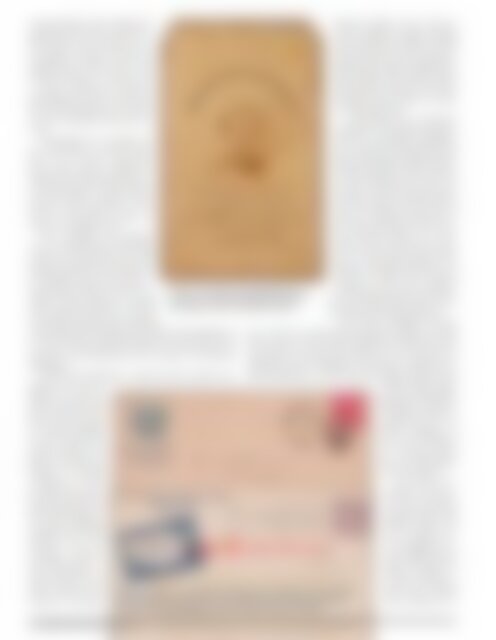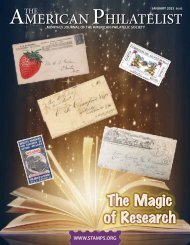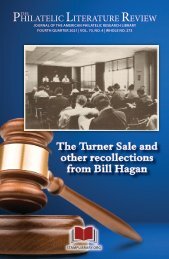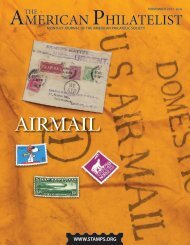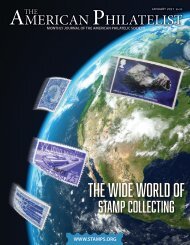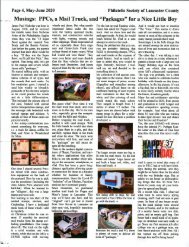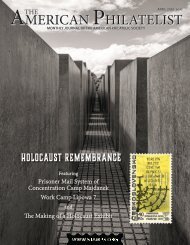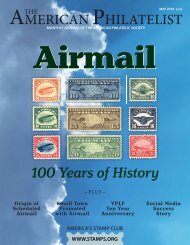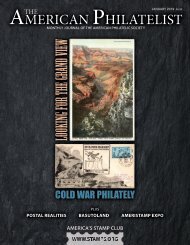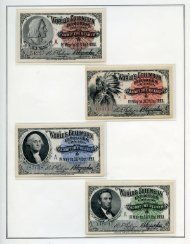August 2018 - Sneak Peek
The American Philatelist is the monthly journal of the American Philatelic Society, the world's largest organization for stamp collectors and enthusiasts. Members receive the printed magazine and can access the digital edition as a benefit of membership in the Society. Please enjoy this sneak peek. We're confident that once you see all that we offer, you'll want to join the APS today.
The American Philatelist is the monthly journal of the American Philatelic Society, the world's largest organization for stamp collectors and enthusiasts. Members receive the printed magazine and can access the digital edition as a benefit of membership in the Society. Please enjoy this sneak peek. We're confident that once you see all that we offer, you'll want to join the APS today.
You also want an ePaper? Increase the reach of your titles
YUMPU automatically turns print PDFs into web optimized ePapers that Google loves.
memorializing a dead toddler and<br />
speaking of his will to avoid alcohol!<br />
In this case the child was incorruptible,<br />
serving as a lesson (or<br />
inspiration) to others. Even circus<br />
huckster Phineas T. Barnum was<br />
a staunch temperance advocate,<br />
promoting the cause of sobriety at<br />
the American Museum in a variety<br />
of ways, including serving only ice<br />
water.<br />
Throughout the remainder of<br />
the 19th century and early 20th,<br />
there were various temperance<br />
groups that sprang up [Figure 7],<br />
among the most powerful of these<br />
were the Woman’s Christian Temperance<br />
Union, founded in 1873<br />
and the Anti-Saloon League of<br />
America, founded in 1893.<br />
On a parallel, but unrelated<br />
note, by the beginning of the 20th<br />
century the government that had<br />
long been involved in raising money<br />
through revenue taxes, and using<br />
stamps and labels to verify consumer<br />
revenue payments, was fully<br />
into taxing the business of commercial<br />
alcohol production by instituting<br />
“beer inspection” and other taxes via the well-established use<br />
of revenue stamps and labels [Figure 8]. In this case the inspection<br />
was ensuring that beer was made of “wholesome”<br />
ingredients.<br />
By the time World War I rolled around, the field of prohibition<br />
was ripe for<br />
tilling. Not only was<br />
the movement heavily<br />
linked with the issue<br />
of women’s suffrage,<br />
but bars (which frequently<br />
allowed only<br />
men) were known as<br />
hotbeds of political<br />
corruption, as well<br />
as a place where husbands<br />
spent much of<br />
the hard-earned family<br />
money drinking.<br />
Added to that is the<br />
fact that – in an increasingly<br />
anti-German<br />
environment –<br />
most breweries were<br />
either owned or operated<br />
by Germans.<br />
Figure 6. A Civil War-era propaganda piece on<br />
a cartes de visite photograph memorializing a<br />
dead toddler, who never imbibed alcohol.<br />
Figure 7. An 1892 cover mailed by the “Department of Narcotics” of the Woman’s<br />
Christian Temperance Union of St. Louis, Missouri and a 1919 cover featuring<br />
another very strong lobby group, the Anti-Saloon League of America.<br />
Patriotic images, such as the one<br />
shown [Figure 9], began showing<br />
up on postcards of the day. As a final<br />
nail, the push to conserve grains to<br />
help feed the soldiers pushed additional<br />
support that would not have<br />
been present otherwise. The WWI<br />
broadside shown [Figure 10] plays<br />
on Americans’ guilt.<br />
In December 1917, a resolution<br />
calling for a Constitutional amendment<br />
for nationwide prohibition<br />
was introduced and passed by both<br />
houses of Congress. Of the 48 states,<br />
36 had ratified the bill by January<br />
16, 1919, making it law (the cover<br />
in Figure 7 notes 45 states by March<br />
29). On October 28, 1919, the Volstead<br />
Act enabled enforcement of<br />
the 18th Amendment when it became<br />
effective January 16, 1920.<br />
Scenes, such as the one shown [Figure<br />
11] on the postcard from 1914<br />
(Kansas’ statewide prohibition was<br />
enacted in 1881) were common<br />
during the early months of Prohibition.<br />
Law enforcement made a show<br />
of seizing and destroying alcohol.<br />
Soon after Prohibition became<br />
law in 1920, its unintended consequences began to be felt<br />
by the nation. Gone were the healthy revenues derived from<br />
the taxation of alcohol and, along with it, the resources to<br />
effectively enforce Prohibition. Soon after, workforces began<br />
diminishing, as various alcohol-related companies that<br />
couldn’t adapt began<br />
to go out of business.<br />
Prohibition wiped out<br />
a huge part of the national<br />
economy. At<br />
the time Prohibition<br />
was enacted, liquor<br />
was the fifth-largest<br />
national industry.<br />
Soon after Prohibition<br />
was enacted,<br />
crime syndicates<br />
sprang up, grew and<br />
thrived under the<br />
new conditions because<br />
illegality of liquor<br />
didn’t decrease<br />
public demand for<br />
alcohol. Bootleg liquor,<br />
often created<br />
from denatured al-<br />
746 AMERICAN PHILATELIST / AUGUST <strong>2018</strong>


